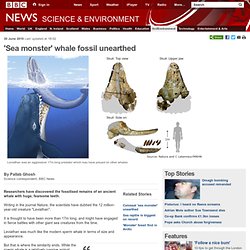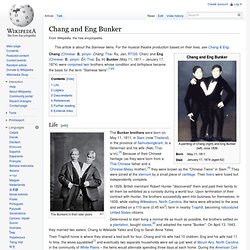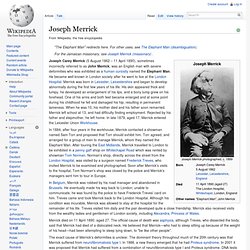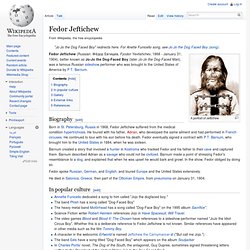

'Sea monster' whale fossil unearthed. By Pallab Ghosh Science correspondent, BBC News Researchers have discovered the fossilised remains of an ancient whale with huge, fearsome teeth.

Writing in the journal Nature, the scientists have dubbed the 12 million-year-old creature "Leviathan". It is thought to have been more than 17m long, and might have engaged in fierce battles with other giant sea creatures from the time. Leviathan was much like the modern sperm whale in terms of size and appearance. Continue reading the main story “Start Quote At the same time in the same waters was another monster... they might have fought each other” End QuoteDr Christian de MuizonNatural History Museum, Paris But that is where the similarity ends. According to Dr Christian de Muizon, director of the Natural History Museum in Paris, Leviathan could have hunted out and fed on large sea creatures such as dolphins, seals and even other whales.
"It was a kind of a sea monster," he said. Sperm whales only have teeth on their lower jaw. Chang and Eng Bunker. Chang (Chinese: 昌; pinyin: Chāng; Thai: จัน, Jan, RTGS: Chan) and Eng (Chinese: 恩; pinyin: Ēn; Thai: อิน In) Bunker (May 11, 1811 – January 17, 1874) were conjoined twin brothers whose condition and birthplace became the basis for the term "Siamese twins".[1][2] Life[edit] The Bunkers in their later years The Bunker brothers were born on May 11, 1811, in Siam (now Thailand), in the province of Samutsongkram, to a fisherman and his wife (Nak; Thai: นาก).[3] Because of their Chinese heritage (as they were born from a Thai Chinese father and a Chinese-Malay mother),[4] they were known as the "Chinese Twins" in Siam.[5] They were joined at the sternum by a small piece of cartilage.

Their livers were fused but independently complete. In 1829, British merchant Robert Hunter "discovered" them and paid their family to let them be exhibited as a curiosity during a world tour. Their Traphill home is where they shared a bed built for four. Joseph Merrick. Joseph Carey Merrick (5 August 1862 – 11 April 1890), sometimes incorrectly referred to as John Merrick, was an English man with severe deformities who was exhibited as a human curiosity named the Elephant Man.

He became well known in London society after he went to live at the London Hospital. Merrick was born in Leicester, Leicestershire and began to develop abnormally during the first few years of his life. His skin appeared thick and lumpy, he developed an enlargement of his lips, and a bony lump grew on his forehead.
One of his arms and both feet became enlarged and at some point during his childhood he fell and damaged his hip, resulting in permanent lameness. When he was 10, his mother died and his father soon remarried. In 1884, after four years in the workhouse, Merrick contacted a showman named Sam Torr and proposed that Torr should exhibit him. Fedor Jeftichew. A portrait of Jeftichew Fedor Jeftichew (Russian: Фёдор Евтищев, Fyodor Yevtishchev, 1868 - January 31, 1904), better known as Jo-Jo the Dog-Faced Boy (later Jo-Jo the Dog-Faced Man), was a famous Russian sideshow performer who was brought to the United States of America by P.T.

Barnum. Biography[edit] Born in St. Petersburg, Russia in 1868, Fedor Jeftichew suffered from the medical condition hypertrichosis. Barnum created a story that involved a hunter in Kostroma who tracked Fedor and his father to their cave and captured them. Fedor spoke Russian, German, and English, and toured Europe and the United States extensively. He died in Salonica, Greece, then part of the Ottoman Empire, from pneumonia on January 31, 1904. In popular culture[edit] Gallery[edit] Fedor Jeftichew, c. 14 years of age. External links[edit] Learn more about Fedor, Lionel and other Hairy Folk from James "Showman" Taylor. References[edit] Hornberger, Francine. 2005.